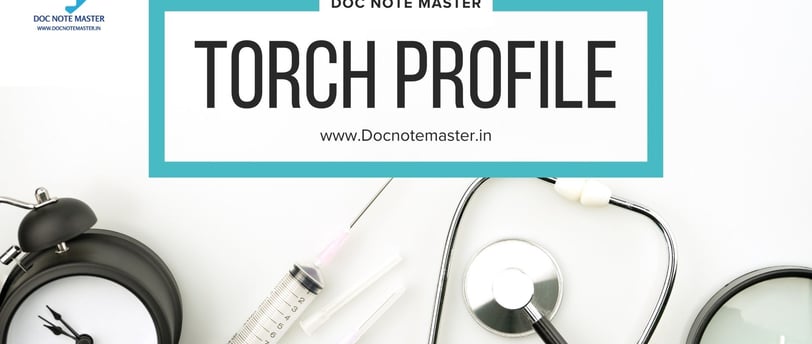online learning with Doc note master|| Himanshu paneru
Torch Profile test
TORCH profile test is a group of blood test which is perform during pregnancy.
MICROBIOLOGY
Himanshu Paneru
2/20/20242 मिनट पढ़ें


TORCH PROFILE TEST
TORCH profile test is a group of blood test which is perform during pregnancy.
Test profile is done to diagnose several infection in newborn.
TORCH infections refer to a group of infectious agents that can potentially harm a developing fetus if contracted by the mother during pregnancy.
Torch infection are responsible for 2 to 3 % of all congenital disorder.
The term ‘’TORCH’’ is acronym of following test
T - Toxoplasmosis
O – Other
R – Rubella
H – Herpes virus
1. Toxoplasmosis
Toxoplasmosis is a disease caused when parasite Toxoplasma gondii enter in body.
Toxoplasma gondii is a single-celled parasite which commonly affect human.
Infant infected with toxoplasmosis in the womb usually don’t show any symptoms for several year.
# Causative agent:
Primary host for this parasite is cat as well as uncooked meat.
# Transmission:
o Mother to child
o Consumption contaminated food & water
o Contact with cat
# Symptoms: symptoms may include
o Fever
o Fatigue
o Muscle aches
o Headache
o Swollen lymph nodes
# Diagnosis:
o Blood test
o Polymerase chain reaction (PCR)
o Ultrasound or MRI
# Treatment:
o Antimicrobial medications
# Complication:
o Blindness
o Miscarriage
o Toxoplasmic encephalitis
2. Other
It include-
a. Chickenpox
b. Epestine barr virus
c. Human immunodeficiency virus (HIV)
d. Hepatitis B & C
e. Syphilis
f. Measles
g. Human parvovirus
h. Mumps
3.Rubella
Rubella, also known as German measles is a virus that cause rashes.
Rubella is a viral infection that can easily passed from person to person through sneezing & coughing.
Side effect of this infection in children is minor
# Causative agent
o German measles is causative agent of rubella
# Transmission:
o Through sneezing & coughing
o Direct contact with infected person
o Contaminated surface
# Symptoms: symptoms may include
o Rashes
o Mild fever
o Conjunctivitis
o Headache
o Swollen lymph nodes
# Diagnosis:
o Blood test
# Treatment:
o No specific antiviral treatment for rubella.
# Complication:
o Congenital Rubella Syndrome.
o Arthritis
o Encephalitis
# Prevention:
o Vaccination
o Good hygiene
4. Cytomegalovirus (CMV)
Cytomegalovirus is a common virus in the herpesvirus family
Most congenital infection in babies
Mother can get CMV by sexual contact
# Causative agent
o Cytomegalovirus
# Transmission:
o Through sexual contact
o Direct contact with infected person
# Symptoms: symptoms may include
· In women
o Muscle aches
o fever
o sore throat
o Headache
o Swollen lymph nodes
· In children
o Jaundice
o Enlarged liver or spleen
o Hearing loss
o Vision loss
# Diagnosis:
o Blood test
o Virus isolation
o Polymerase chain reaction
# Treatment:
o Antiviral medications.
# Complication:
o Pneumonia.
o Gastrointestinal complications.
o Central nervous system disorders
o Vision problem
# Prevention:
o Avoid close contact with infected person
o Good hygiene
5. Herpes simplex virus
Herpes Simplex Virus is a highly prevalent & contagious virus belongs to Herpesviridae family
There are two main types of HSV:
a. Herpes Simplex Virus Type 1:
o HSV-1 cause oral herpes infections which affect mouth, lips & face.
o HSV-1 can also cause genital herpes through oral-genital contact.
b. Herpes Simplex Virus Type 2: HSV-2 primarily causes genital herpes.
# Causative agent
o Herpes Simplex virus
# Transmission:
o Through sexual contact
o Direct contact with infected person
o Oral – genital contact
# Symptoms: symptoms may include
Common symptoms
o Muscle aches
o fever
o sore throat
o Headache
o Swollen lymph nodes
Other symptoms
o Blisters around mouth or genital area
# Diagnosis:
o Virus isolation
o Polymerase chain reaction
o Serological test
# Treatment:
o Antiviral medications.
# Complication:
o Meningitis
o Encephalitis
o Neonatal herpes
o Increase risk for HIV infection
# Prevention:
o Avoid sexual contact during HSV
o Using barrier methods such as condoms
o Do not share personal items such as towles
